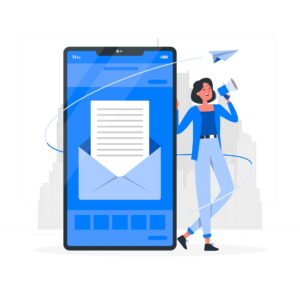Email marketing remains one of the most powerful tools in a marketer’s arsenal. Its ability to directly engage with the audience, build relationships, and drive conversions is unmatched. In this comprehensive guide, we will explore the various strategies and techniques to leverage email marketing effectively and maximize its impact on your business.
Understanding the Basics of Email Marketing
1. What is Email Marketing?
- Definition and Importance: Email marketing is a digital marketing strategy that involves sending emails to a group of recipients with the aim of promoting products, services, or building relationships. Its importance lies in its direct and personalized approach, making it a powerful tool for businesses to engage with their audience.
- Benefits of Email Marketing: Explore the advantages of email marketing, such as cost-effectiveness, high ROI, and the ability to reach a global audience. Emphasize how it can be used for lead generation, customer retention, and nurturing prospects.
2. Types of Email Marketing Campaigns
- Promotional Emails: Discuss how promotional emails are designed to promote products, services, or special offers. Explain the role of calls to action (CTAs) and the importance of delivering value to recipients.
- Transactional Emails: These include order confirmations, shipping notifications, and receipts. Emphasize their role in building trust and improving the customer experience.
- Newsletters and Updates: Explain how newsletters keep subscribers informed about company news, industry trends, and valuable content. Discuss the importance of consistency and content quality.
Building a High-Quality Email List
1. Permission-Based Marketing
- Importance of Permission: Stress the significance of obtaining explicit consent from individuals before sending them marketing emails. Highlight that permission-based marketing leads to higher engagement and compliance with email laws.
- Obtaining Consent: Opt-In Strategies: Provide strategies for obtaining consent, such as using double opt-ins, clear privacy policies, and transparent sign-up forms.
2. Segmentation and Personalization
- Segmentation Strategies: Explain how segmenting your email list into distinct groups based on demographics, behavior, or preferences allows for targeted and relevant content delivery.
- Personalization Techniques: Describe how personalization can be achieved through dynamic content, personalized subject lines, and tailored recommendations. Discuss its positive impact on open rates and conversion rates.
Crafting Compelling Email Content
1. Writing Effective Email Copy
- Creating Attention-Grabbing Subject Lines: Discuss techniques for crafting subject lines that pique curiosity, create urgency, or offer a benefit.
- Crafting Engaging Email Body Text: Explain how to maintain a conversational tone, present a clear value proposition, and use storytelling techniques to engage readers.
2. Visual Appeal and Multimedia
- Importance of Visuals: Stress the significance of incorporating images and graphics to make emails visually appealing. Discuss the role of branding and consistent design.
- Incorporating Videos and Graphics: Explore how videos and infographics can enhance the email content, making it more interactive and engaging. Discuss best practices for multimedia integration.
Designing Responsive and Mobile-Friendly Emails
1. Responsive Email Design
- Importance of Mobile Optimization: Emphasize that a significant portion of email opens occur on mobile devices. Explain why responsive design ensures a seamless user experience across different screen sizes.
- Tips for Responsive Email Templates: Offer practical tips for designing responsive email templates, such as using a single-column layout, optimizing images for mobile, and using large, tappable buttons.
2. Testing and Optimization
- A/B Testing for Email Elements: Discuss how A/B testing can be used to test different elements of emails, including subject lines, CTAs, and content. Highlight the importance of iterative testing for continuous improvement.
- Analyzing Results and Iterative Improvements: Explain how to analyze email marketing metrics, identify areas for improvement, and make data-driven decisions to optimize future campaigns.
Automating Email Campaigns
1. Benefits of Email Automation
- Time and Resource Efficiency: Discuss how email automation streamlines the email marketing process, enabling businesses to reach the right audience with relevant content at the right time.
- Personalization and Segmentation: Highlight how automation allows for highly personalized and segmented email campaigns, improving relevance and engagement.
2. Setting Up Automated Workflows
- Welcome Emails for New Subscribers: Explain the importance of welcoming new subscribers with automated emails and provide tips for creating effective welcome sequences.
- Abandoned Cart Emails: Discuss how automated abandoned cart emails can recover potentially lost sales by reminding shoppers of their unfinished purchases.
- Drip Campaigns: Describe the concept of drip campaigns, which gradually nurture leads with a series of automated emails. Provide examples of drip campaign workflows.
Ensuring Email Deliverability and Compliance
1. Email Deliverability Best Practices
- Avoiding Spam Filters: Provide guidance on how to avoid spam filters by using authentic sender addresses, relevant content, and avoiding spammy practices.
- Maintaining a Clean Email List: Explain the importance of list hygiene, including regularly removing inactive or bounced email addresses.
2. Understanding Email Laws and Regulations
- CAN-SPAM Act (US): Outline the key provisions of the CAN-SPAM Act, including requirements for clear identification, opt-out mechanisms, and physical mailing addresses in emails.
- GDPR (EU): Explain the General Data Protection Regulation (GDPR) and how it applies to email marketing, including consent requirements and data protection.
- Compliance and Subscriber Rights: Emphasize the importance of respecting subscribers’ rights, including the right to opt out and request data removal.
Analyzing Performance and Optimizing Campaigns
1. Key Email Marketing Metrics
- Open Rates, Click-Through Rates, Conversion Rates: Define and explain the significance of these key metrics in assessing the effectiveness of email campaigns.
- Bounce Rates and Unsubscribe Rates: Describe how bounce rates and unsubscribe rates indicate list health and engagement levels.
2. Interpreting Data and Making Informed Decisions
- Identifying Successful Campaigns: Explain how to identify which email campaigns are most successful by analyzing metrics and comparing them to your goals.
- Implementing Changes Based on Analytics: Discuss how to use insights gained from email marketing analytics to make improvements, refine strategies, and iterate on future campaigns.
Conclusion
Mastering email marketing is an ongoing process that combines creativity, data analysis, and compliance. By understanding the fundamentals, crafting compelling content, embracing automation, and adhering to email laws, businesses can effectively harness the power of email marketing. Ultimately, success in email marketing is not just about sending messages; it’s about building lasting relationships with subscribers and providing ongoing value, which leads to sustained business growth.


